

Small Craft Advisor
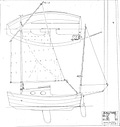
Boat Designs: Evaluating SCAMP’S Big Sister
(this new welsford cruiser checks a lot of boxes…).
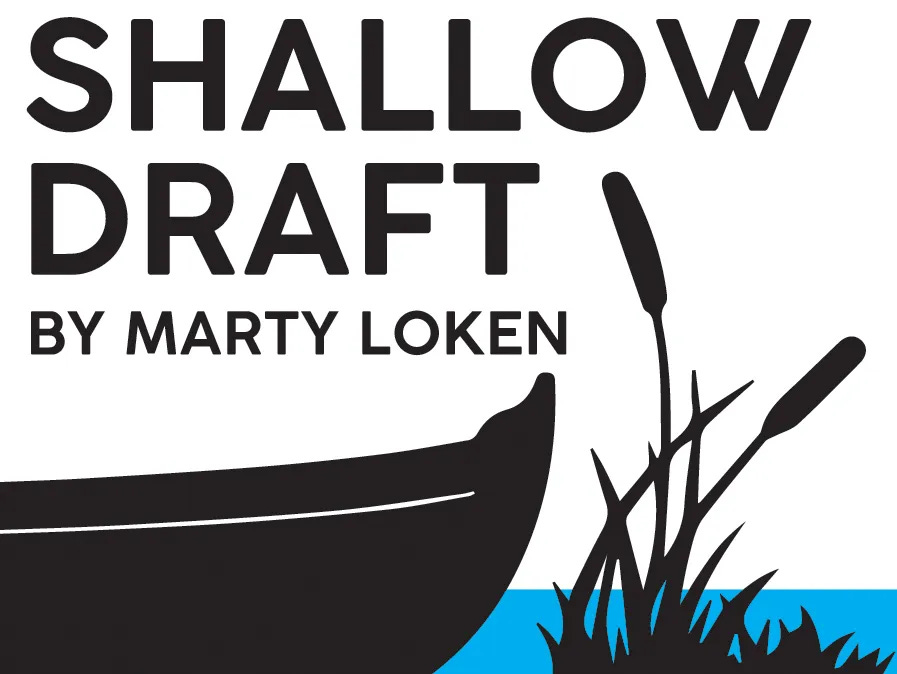
Over the past few days I’ve had email exchanges with John Welsford, New Zealand designer, regarding a brainstorm that’s been percolating in his clever, whimsical noggin: A bigger, more commodious takeoff on his wildly popular SCAMP design.
As most SCA readers know, the 11’ 11” SCAMP design was conceived 13 years ago when Josh Colvin, editor of this fine publication, asked Welsford to come up with a new kind of small cruising boat—one small enough to explore the most hard-to-penetrate backwaters, while being easy to rig, light enough to trailer with the smallest of tow vehicles, surprisingly great under sail, and comfy for overnight camp-cruising adventures. So, following some tweaks by designer and master boatbuilder Kees Prins, the resulting sailboat was dubbed SCAMP, for Small Craft Advisor Magazine Project.
SCAMP DRAWING…
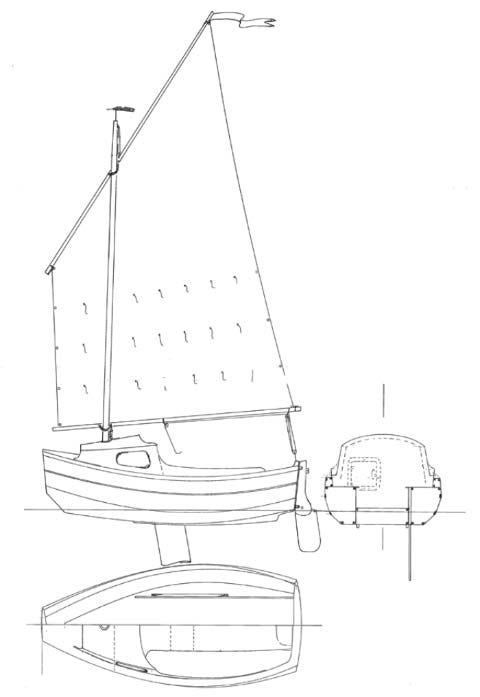
The rest is history: More building plans and kits for SCAMP have been sold over the years than any other small cruising boat we can think of. Besides the original wooden version, Gig Harbor Boat Works was licensed in 2013 to produce a fiberglass SCAMP, and the little giant killer—in wood and fiberglass—has since its debut been at the center of various small-boat rallies, workshops and sailing events.
While SCAMPs are still being built worldwide by enthusiasts, plan and kit sales have slowly been approaching what might be a kind of saturation point. It’s not that “everyone who wants a SCAMP has already built one,” but we get the feeling that it’s time for something new and different—like a SCAMP-inspired design that has the personality and quirky appeal of the original boat, but with more creature comforts (for an aging population of SCAMP lovers).
Meet SCALLYWAG, John Welsford’s big sister to SCAMP, a 15’ 4” x 7’ 3” wonder with a “real” cabin, tabernacle mast, mizzen sail, powerful main, water-ballast tanks, sitting headroom down below…and like SCAMP, faster than many onlookers might expect.
SCALLYWAG DRAWING…

This might turn out to be a timely, common-sense follow-up to the successful SCAMP design—so tempting that John Welsford is talking about building one for himself.
(As a footnote, we might add that in 2008, prior to the introduction of SCAMP in 2010, Welsford came up with another design that was similar to but somewhat larger than SCAMP—called TREAD LIGHTLY, which measured 13’ overall, with a beam of 5’ and addition of a mizzen. The series of similar hulls began with PEANUTS, an experimental build that never quite made the plans list. That design led to TENDER BEHIND, then SHERPA, then TREAD LIGHTLY, then SCAMP, then SCRAPS and now SCALLYWAG. Quite a series!)
TREAD LIGHTLY drawing…immediate predecessor to SCAMP)
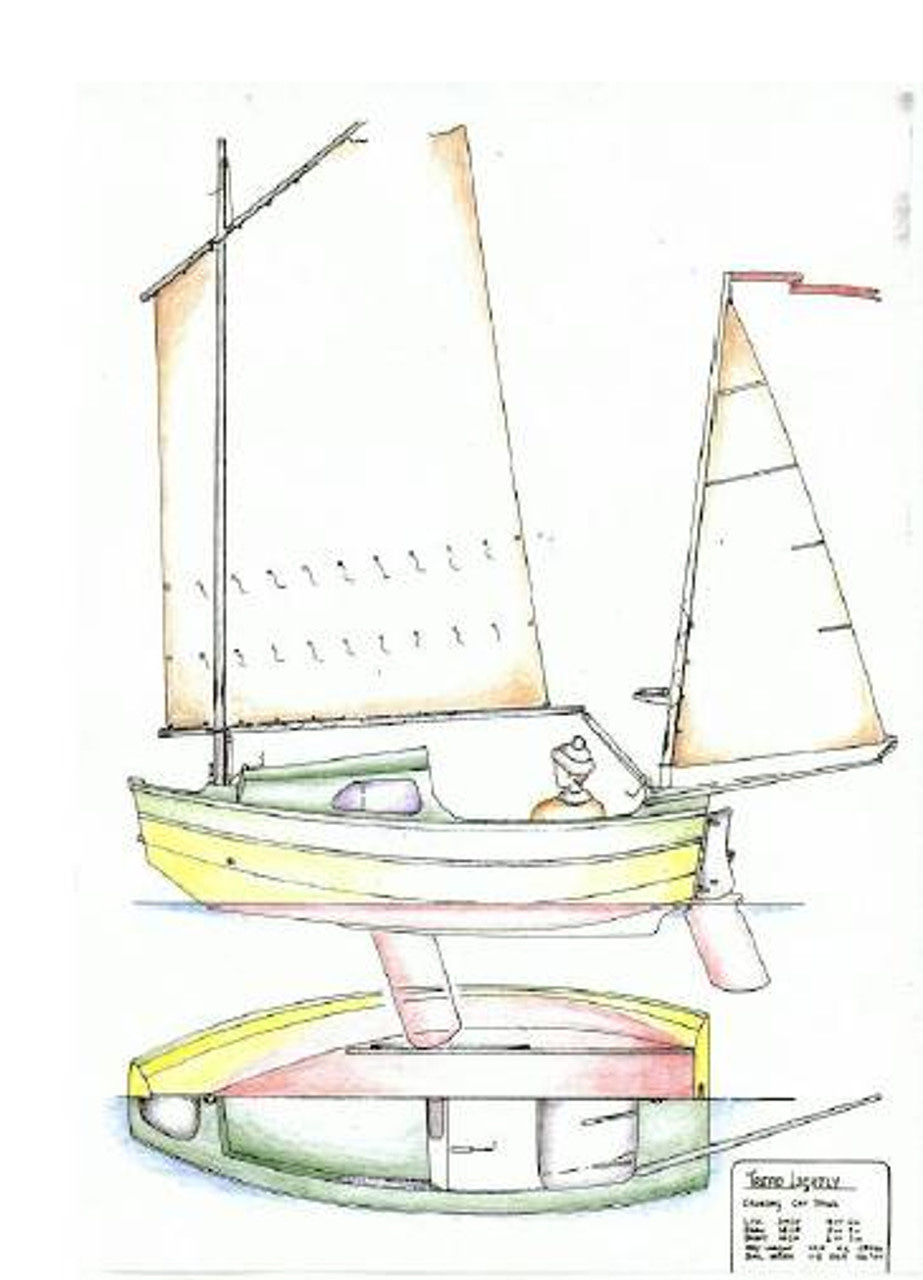
Here is John Welsford’s description of the SCALLYWAG design:
“I’ve had a number of people tell me they love SCAMP, but they’d like a ‘real’ cabin—something that would provide shelter for a couple of friends to overnight out of the rain; somewhere with space enough for four to sit and chat over coffee or rum on a cold evening; somewhere with a bench for a cooker, a table to eat the food off of, and lockers for all the essentials…and room for the skipper and first mate to stretch out and sleep in comfort.
“SCALLYWAG is not so big as to make launching and retrieving a chore; her mainmast is in a tabernacle, which makes standing it up easy-peasy for clients who don’t like the idea of lifting a mast that size vertically into place. Her mizzen is light enough to not be a worry, too, in that respect.
“The rig is a powerful one, but easy to access for reefing, and she will heave to under mizzen with the main let free so she sits mostly head-to-wind, dry and restful if a gust has to be waited out.
“I’ve added a pair of big water tanks for ballast, so with that and her beamy shape she’ll be very stable. Her cockpit self-drains, the motor is inside the tall transom for easy access, and while there’s room in the cockpit for four, she’ll be easy to single-hand and relaxing to sail.
“While the relationship between SCALLYWAG and SCAMP is obvious, it’s not just the styling. The backroom calculations in hydrodynamics suggest she’ll handle well, and be faster than many expect. With high stability and the ability to sit upright when aground, she’ll be able to transition from hiding in the mud or sand up a creek somewhere, to making a longer coastal passage without any fuss.
“Construction is simply plywood over ply bulkheads, with stringers to line everything up, and with considerable buoyancy just in case. The plans will have scale drawings of all major components, and we anticipate soon having printable full-sized templates for frames and other key items.”
As for specifications, beyond the overall length of 15’ 4” and beam of 7’ 3,” SCALLYWAG will have board-up draft of 10,” a board-down draft of 3’ 4,” a total sail area of 143 s.f. and a fully-rigged dry weight of 750 lbs. (Incidentally, the beam-to-length ratios of SCAMP and SCALLYWAG are almost identical.)
John Welsford says that plans for SCALLYWAG will be available on December 1, but he can take orders in the meantime. Price will be $245 U.S. funds for emailed, printable PDFs, and the plans can be ordered via John’s website: jwboatdesigns.co.nz (Joel Bergen, well-known for the Welsford Navigator he built and sails in many Northwest small-boat events, will be developing a set of SCALLYWAG patterns in the not-distant future, according to Welsford. Editor’s note: We heard from Joel yesterday; he’s hoping to develop CAD-produced patterns “in a few weeks,” now that he’s received initial SCALLYWAG drawings. Stay tuned; we’ll provide updates on plans and patterns in this space.)
FIRST IMPRESSIONS OF THE SCALLYWAG DESIGN:
Eager to hear what SCAMP-savvy friends might have to say about the SCALLYWAG specs and just-released drawing, we sought initial reactions from…
JOSH COLVIN, editor of Small Craft Advisor , who commissioned the SCAMP design in 2010 and enjoys sailing SCAMP #1:
“There’s certainly no doubt who designed this one! It looks almost as much like Welsford’s PENGUIN as a SCAMP. SCALLYWAG’s length is a sweet spot in terms of accommodations potential. She’ll be rowed less than most SCAMPs, but I love the inboard motor well to keep her lines clean, and the engine right at hand. But her most exciting feature is the addition of the mizzen, which will improve seaworthiness and make managing the mainsail easier.
“Between LONG STEPS and SCALLYWAG, those looking for something like SCAMP, but larger, have great options. I’m excited to see the first boat built—she will be bigger than most expect, just looking at the drawing.” SIMEON BALDWIN, builder of an early SCAMP who has perhaps sailed more nautical miles with a SCAMP than anyone…and who has also served as a generous advisor to fellow SCAMP builders and is an expert on rigging and sailing the little 11’ 11” boats:
“I like what I see of this long-rumored design. Knowing John and his attention to ergonomics, I can anticipate it will work well. The tabernacled mast and addition of a mizzen are most appealing.
“From the drawing I think it may resemble LONG STEPS in terms of the recessed footwell. It also appears he is eschewing a by-design lazarette made popular by many SCAMP owners.
“The double water tanks are something to contemplate. I don’t envision SCALLYWAG as a purpose-built racer with crew, actively keeping high-side ballast on long tacks, like the SKATE 15 that Brandon Davis designed, which utilizes two tanks and a dump-valve system that may be more elaborate than a typical cruising sailor would want to live with. But John may be describing two water tanks that are filled and remain separate from one another.”
(Editor’s note: Welsford’s comment on tanks, “The ballast tanks are linked, and they’re not far enough off the centerline to work independently. There is one each side of the aft end of the centerboard case and they go out as far as the seat-front extensions.”)
“I’m looking forward to how all of this works out!”
BRANDON DAVIS, of Turn Point Design in Port Townsend, whose company cuts CNC kits for the SCAMP and a variety of other small boats. Brandon is also a skilled designer and small-boat sailor:
“I really like this boat, since it has just enough room to have a cabin but it’s still small enough to be trailered, beached and easily built in a garage. The enclosed cabin should encourage longer trips or taking a friend along.
“The longer waterline should increase average sailing speeds. My guess is that rowing speed will be lower than the SCAMP, as the rower will not be able to take advantage of the waterline length because of her weight.
“Will SCALLYWAG be offered as a kit? I could see it selling well as a kit and the market could be ripe. Many SCAMP builders might consider this as their next build.
“I look forward to seeing the first SCALLYWAGs on the water!”
KEES PRINS, designer and boatbuilder, who constructed the first SCAMP while serving as boatshop manager at the Northwest Maritime Center…and in the process suggested and implemented some changes that improved the design:
“I think SCALLYWAG will find a great following in the SCAMP world and beyond. Adding a cabin will greatly enlarge the ‘SCAMP Crowd.’ At that beam, and with twin ballast tanks, stability should be enormous for a boat this length. I would have liked to see a cross section through the cabin to know more about sitting comfort. (Four people hanging out inside seems a little optimistic, but two should be comfortable.)
“I’m curious about what the tabernacle for the unsupported mast will look like. A big sail area, together with a stiff hull will induce a significant load on the tabernacle. There seems to be a deep well for the mast base to swing through, judging by the drain hole.
“All in all, SCALLYWAG looks very promising.”
OSCAR LIND, a serious student of all various small-boat designs , and earlier builder of a SCAMP, who shares at least one thing in common with John Welsford—they’ve never met a pun they didn’t like:
“I might have to clear out the shop and make as much room as possible to build this boat (due to the 7’ 3” beam, especially). It’s so tempting and fills the bill for usability and function.
“It does need a Chinese lug rig, though. I expect quite a few SCALLYWAGS will ultimately be built.”
(Editor’s note: John Welsford comments, “I like the Chinese lugsail, but for a sail of this size on a boat that will be trailered, rigged and derigged for each outing and dry-stored, the extra complexity of the Junk sail slows the process. As well, the balanced lug is in my experience, a little quicker upwind—unless the junk rig has cambered-panel sails, and there are few sailmakers producing those, so I think in this case, simplicity and performance get the nod.”)
As for my personal view as a serial boatbuilder, restorer and sometimes buyer of project boats, I enjoyed owning a SCAMP several years ago. While I loved sailing the boat, I wished it was bigger and included a sleeping cabin. So, John’s new SCALLYWAG design checks many more boxes as an all-around keeper, and I prefer its overall hull, cabin and rig design, not to mention its potential as a serious cruising machine.
So, once again, here’s a chance for you, as a fellow boat nut, to offer your evaluation of SCAMP and her newly-hatched big sister, SCALLYWAG. (Also, please add other thoughts in the comments section below…) • SCA •
| · Liked by Joshua Colvin, Marty Loken
|
| Liked by Marty Loken
|
Ready for more?

SCAMP SAILBOAT & The Red Lantern Fleet
© 2024 Scamp Sailboat / Jib & Jigger Incorporated
YOUR OWN SCAMP
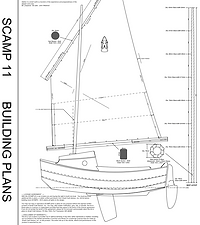
Build from Plans
Ready to build your own? You can order your own set of printed plans or a PDF download right here at this site. Welcome aboard!

Build from a Kit
The famously detailed CNC-cut SCAMP kits are available all over the world. See links below to find an authorized kit reseller or buy here and get started the easy way.

Buy a Fiberglass Model
Why build a SCAMP when you can start sailing and exploring now? The renowned fiberglass SCAMP from Gig Harbor Boat Works can be customized to your tastes as well. Click here to visit their site.
Dave Lucas, FL
It was blowing a solid 12 to 15 with higher gusts and us hot-rodders were having a ball showing off and speeding around the slower boats when what do I see ahead of me but a Scamp. ... only a hundred yards or so so we figured to catch him in about two minutes; it didn’t work out that way. It took us about two miles to finally get to him ...These guys were just sitting drinking beer and hauling ass easy as you please. They could tack and jibe and mess around like it was dead calm, where we were having to be really careful. That’s impossible—this kind of performance cannot come from a clunky little 12-foot boat. This thing somehow ignored everything I thought I know about hull speed. I strongly recommend this boat to anyone who wants a simple, lightweight, safe, dry, fast boat.”
Our own youthful dreams often featured small boats in starring roles. Aboard these simple, stalwart little vessels we'd venture across nebulous bodies of water in search of distant wild shorelines or uncharted islands. We'd land, hike into the interior, and make camp. But always our boats offered refuge from any threat, including summer storms, which we'd wait out beneath our boom tents. At night we'd read sea stories by oil lantern and sleep under a blanket of stars.
Curiously, never once did these visions include negative images of wrestling with a heavy mast and complex rigging, fussing with a smelly, recalcitrant outboard, or being held off shore by our boat's draft. And even when we pictured the afternoon breeze kicking up whitecaps, never once did the vision include a chilly capsize.
It was the dream of returning to those simple pleasures that inspired thoughts of S.C.A.M.P. (Small Craft Advisor Magazine Project). That and a persistent desire to go over "there"—that place we often see but are unable to reach. It seems to happen on every cruise. Never mind that we're usually sailing the smallest boat around for miles, we always come upon some ultra-shallow lagoon or serpentine tidal stream that disappears into the reeds, trees and rushes. To get in there—to really commune with nature—a boat needs to be light, shallow and easily propelled—and preferably flat-bottomed in case we decide to stay right though the ebb. —Josh Colvin
Features : Water Ballast Tank • Offset centerboard • Massive Flotation Stowage Cabin • "Veranda" Overhanging Cabintop • Kickup Rudder Flat Bottom and Skegs for Beaching • Voluminous Stowage Lockers 8' 3" Cockpit Sole Single Berth • Convert Cockpit Seats to Double Berth
Designer : John Welsford
Additional Development: Kees Prins, Brandon Davis, Howard Rice

First Launched
Sail Numbers
11'11"
Length Overall
Approximate
MANY WAYS TO SCAMP

SCAMP MERCH

SCAMP Building Kit + Foils

SCAMP Red Lantern Crew Neck Sweatshirt

SCAMP Red Lantern Shirt

SCAMP Building Plans PDF DOWNLOAD

SCAMP Building Plans

SCAMP Articles Package

SCAMP Brass Name Plate

Limited Edition SCAMP Poster

A Boat Called SCAMP

Official SCAMP Burgee
SCAMP LINKS
Ordering plans or kits.
United States
Small Craft Advisor
Duckworks Boat Builders Supply
Little Wooden Boat Company
Jordan Boats
Denmark/ E.U.
Boatkits.eu
Owner Gallery
Do you own a SCAMP? Make sure to send us a photo of your boat for our Gallery page above.
Talk to other fans and owners at our Group page above, or at a popular Facebook group.
Ordering fiberglass model.
Gig Harbor Boatworks
Rigging and Sails
Talk to other owners, builders and fans at the scamp message board here, our group page above, or at a popular facebook group., ordering kits.
FRANCE/ U.K./ E.U.
Newyd Marine
SCAMP Building Camps
The pocket yacht, small craft advisor magazine.
Do you own a SCAMP? Make sure to send us a photo of your boat for our Gallery page above. Send your photo with your name, boat name and sail number to: [email protected]
Talk to other owners, builders and fans at our SCAMP Message Board , or here at Group page above, or at a popular Facebook group.
International registry, popular scamp youtube videos of the boat in action. intentional capsize scamp agility scamping around gig harbor scamp scamp in everglades challenge scamp 3-day cruise scamp video tour.
For other questions contact: [email protected]
Copyright Jib & Jigger Incorporated DBA Small Craft Advisor

Call Us: (253) 851-2126 Mon-Fri 9-5 Pacific Time
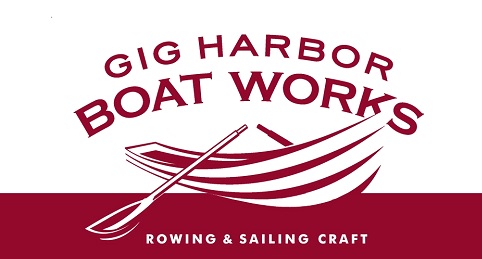
Fiberglass SCAMP review in 48 North
by GHBoats Webmaster | Apr 12, 2014 | Press Reviews , SCAMP

Our fiberglass SCAMP got a fantastic write-up in the April 2014 issue of 48 North !

It’s a pretty good sized article so we’re not going to reprint the whole thing here, but these are a few of our favorite parts:
Gig Harbor Boat Works, known for their strong, esthetically pleasing rowing boats, has already shipped a number of the new SCAMPS all over the country and overseas. “The kit boat has a lot of intricate details that the home builder may not have the talent or tools to build,” says Dave Robertson, owner of GHB. “With the fiberglass version, they can enjoy using the boat right away.” The GHB boat is truly sail-away complete; from oars to sails.
There are many innovations designed into the SCAMP that make it truly a big little boat. One thing that usually takes up a lot of cockpit room of most small boats is the centerboard. The SCAMP’s centerboard, very heavy but swings up easily for trailer or grounding, is offset to starboard so that it doesn’t intrude into the cockpit. I’ll let you call Dave to explain the physics of the offset. Suffice it to say that we didn’t notice a difference on either tack. The result is it opens up the cockpit which feels more like that of a of a San Juan 24.
The boat was surprisingly quick and very stable. “This boat can’t be just 12’long,” I thought. I stood up and rocked it side to side with minimal affect. It felt like 20-footer. Sailing the SCAMP made me a believer that it actually would be a safe and enjoyable way to explore the San Juans, as well as just knocking around the bay for a fun day of sailing. The SCAMP had lots of surprises, all good. I have to say it’s the biggest little boat I’ve ever sailed.
You can download a PDF of the full review here: 48 North Scamp Review
Newest Posts
- Annapolis Sailboat Show Oct 10-14, 2024
- Small Boat Festival at Port Ludlow – July 27th
- Lobster Boat Update #3: Preorders Now Open!
- “Pale Valley” Salish Voyager Finishes Strong in Seventy48
- See You at Anacortes Boat & Yacht Show, May 16-18!
- Beach Dolly (1)
- Best of GHBoats (5)
- Customer Questions (8)
- Customization (1)
- Galleries (4)
- Maintenance and Repairs (3)
- Announcements (13)
- Boat Shows (15)
- Just for Fun (17)
- Mailbag (44)
- Newsletters (25)
- Ocean Rowing (13)
- Press Reviews (10)
- Now Hiring (1)
- Woodwork (3)
- Captain's Gig (2)
- Jersey Skiff (4)
- Lobster Boat (5)
- Melonseed (6)
- Navigator (4)
- Nisqually (2)
- Point Defiance (7)
- Salish Voyager (18)
- Swampscott Dory (1)
- Whitehall (7)
- Sea Stories (13)
- Site Guide (4)
Blog Archives
Site search.
Boat Profile
A little camp cruiser for big dreams
From Issue Small Boats Annual 2016 October 2015
N ever mind that until grounding on a mudflat less than 30 miles from the finish line, SCAMP #4 breezed through a difficult year in the 300-mile Everglades Challenge adventure race a few years ago, pressing on comfortably when many bigger boats had to quit. Never mind that during the inaugural Race to Alaska earlier this year, SCAMP #11 completed a very rough 40-mile open-water crossing of the Strait of Juan de Fuca, taking its solo skipper safely from Port Townsend, Washington, to Victoria, British Columbia. And never mind that yet another SCAMP (extensively modified for the venture by its builder) may attempt to round Cape Horn—yes, that Cape Horn—this year and, if successful, will be the smallest sailboat ever to do so. Despite all that, the overwhelming impression I get when Dave Ender drives up with his newly built SCAMP to take me sailing is: What a cute little boat.
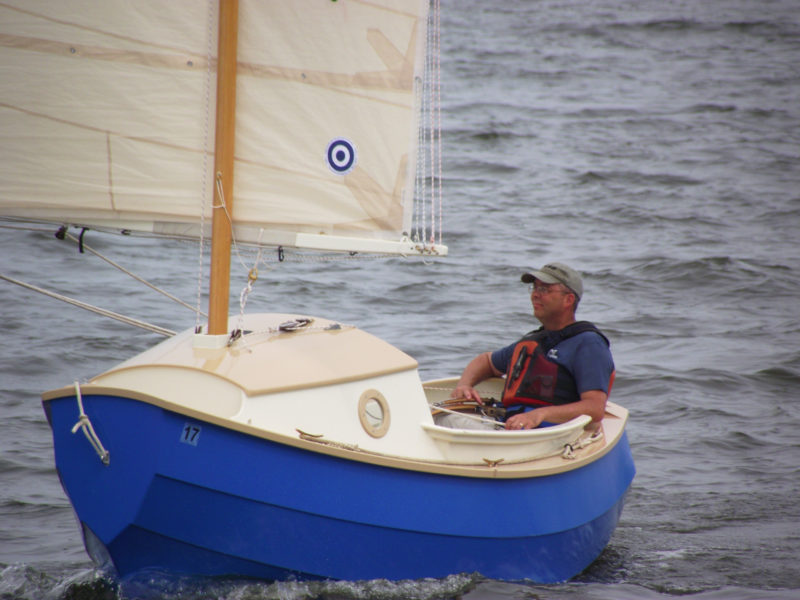
The buoyancy of the blunt pram bow resists digging in while running downwind and reduces the likelihood of broaching.
SCAMP is short, curvy, beamy, and high-sided, with a well-rockered flat bottom and a distinctive pram bow—a cross between a bulldog, a basketball, and an angry rubber duck. It’s also one of the easiest-launching boats I’ve ever encountered. I barely had time to grab my gear before Ender had the boat rigged and ready: mast stepped, sail hoisted, and rudder hung on the transom. He backed the trailer into the water and shoved SCAMP off. Less than 10 minutes from arrival and it was time to sail.
Josh Colvin, who commissioned SCAMP—an acronym for Small Craft Advisor Magazine Project—wasn’t looking for an ultimate adventure boat when he approached New Zealand designer John Welsford (see WB No. 225 for a profile on Welsford and his design work). “My initial goals for the boat were based largely on a 150-mile sail down the Columbia River, from Beacon Rock to Astoria,” Colvin says. “I kept coming across backwaters and shallow estuarine areas and thinking, That’s where I really want to go , but my 16-footer was too deep, wasn’t easy to row, and if I wanted to overnight up among the reeds, wouldn’t dry out level if the tide left. So the idea I eventually took to John Welsford was for the smallest possible boat that would be able to do all of these things, but still be seaworthy enough to cope with something like the middle of the Columbia River on a breezy afternoon.”
Judging by SCAMP’s popularity among amateur builders—roughly 340 kits or plan sets have been sold since 2011, with about 60 boats launched—plenty of other people are interested, too. Designer John Welsford sees SCAMP as a sort of 21st-century version of a much-loved classic, the Mirror dinghy. “While we don’t expect to do anywhere near as many boats,” Welsford says, “it’s hitting a similar, but older market.” Along the way, SCAMP has fostered an enthusiastic and supportive community of builders and owners, encouraging new builders to take the plunge.
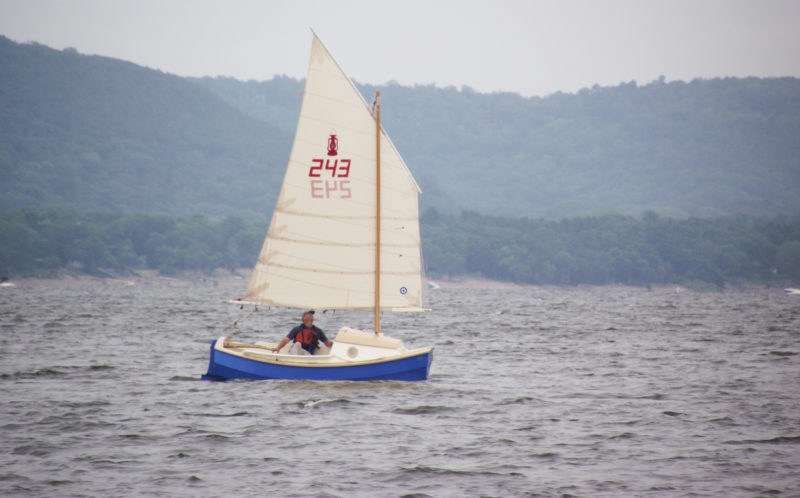
The SCAMPS’s 100-sq-ft sail is set high for good visibility under the boom and is easily reefed.
To bring the new design to life, Welsford was able to make good use of his previous experimentation with similar boats. “SCAMP is number six in a series of very beamy, shallow-bodied boats with that distinctive high-positioned pram bow,” Welsford says. “Tender Behind, Tread Lightly, and Sherpa are the other designs that made it to plans. All work really well, can carry huge loads for their size, sail well, and are well balanced. I learned something from each of them, and SCAMP is a result of that learning.” Besides Welsford, boatbuilder/designer Kees Prins of Port Townsend, Brandon Davis of Turnpoint Design , and adventurer/prototype tester Howard Rice all contributed to final design details and kit elements for SCAMP.
SCAMP is built upright on its flat bottom, which serves as the base for an egg-crate arrangement of plywood that forms the boat’s furniture and structural members. No temporary molds or frames are used. It’s a method that makes for an exceptionally stiff hull, and a safe one—the completed “boxes” create six entirely separate buoyancy chambers within the glued-plywood lapstrake hull. Welsford reports that one SCAMP was able to remain comfortably afloat despite suffering “a hole in the side that you could put your head through” after hitting a snag. And although there are plenty of parts to assemble when building a SCAMP, no single step requires more than moderate woodworking skills and a selection of basic tools.
S CAMP is rigged with a single balanced lugsail, an excellent choice for a cruising rig that’s simple to handle and easy to reef. With 100 sq ft of sail and the stability to stand up to it, the boat also performs well. On my second sail in a SCAMP, working to windward on a gusty day, I was able to keep ahead of a 21′ Sea Pearl for several miles. SCAMP’s shallow draft and flat bottom make it a perfect gunkholer, and 173 lbs of water ballast (roughly 40 percent of the total hull weight) make it capable of much more. It’s no pulling boat, but SCAMP won’t be too difficult to move under oars when necessary. Some builders have considered experimenting with a single sculling oar at the transom; Dave Ender plans to try a yuloh. There’s room to mount a small outboard on the transom for backup propulsion.
Builders have the choice of building from plans or from a kit, with custom sails and hardware available for purchase. Another popular option for builders is the SCAMP Camp , a two-week intensive class in which participants come together to assemble their own SCAMP kits under the direction of designer John Welsford and prototype tester Howard Rice.
One unintended feature of the design deserves mention: several SCAMP builders I have met describe the boat as “a chick magnet,” and from my own observations at various messabouts and festivals, I’d say that such a claim is closer to reality than to hype. For potential builders with wives or girlfriends reluctant to take up sailing, this might be the single biggest advantage SCAMP has to offer.
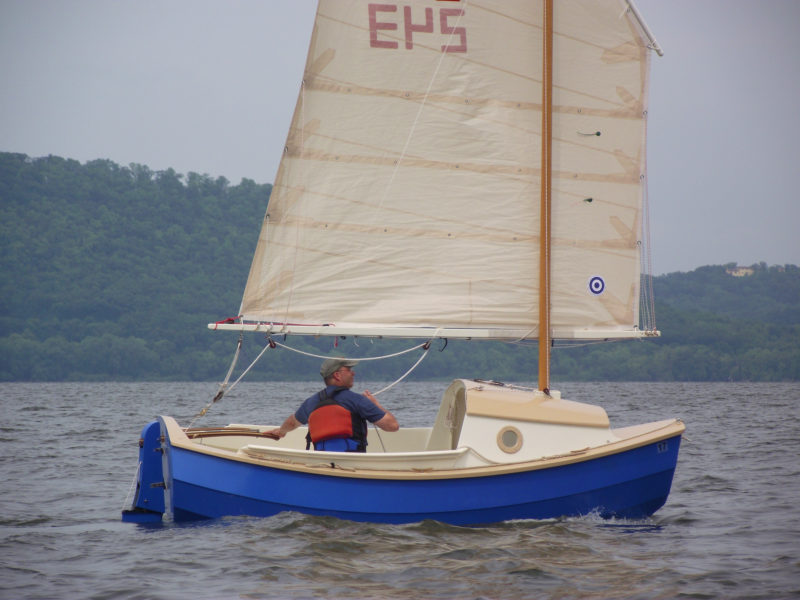
A kick-up rudder allows sailing in shallow water and twin skegs help the SCAMP sit solidly upright when grounded.
B ack aboard Dave Ender’s Scamp, we were away from the dock with an easy shove, heading across Lake Pepin, a wide stretch of the Mississippi that’s often subject to strong winds sweeping down between tall bluffs. Dave filled the ballast tank under the cockpit sole. With the drain holes open, the tank floods itself almost completely; the top of the tank is a few inches above the waterline, so must be topped off by replacing the plugs and pouring water in with a bucket from the cockpit before sealing. He could pour water in quickly without worrying about spilling or overflowing: The excess water drains out of the cockpit’s scuppers. With the water ballast in, we soon shook out the reef we started with, and Dave put me at the tiller. It was a windy day, but even under full sail we continued on in perfect comfort. SCAMP may be a small boat, but it’s the biggest small boat I’ve ever sailed. In fact, it’s almost impossible to categorize SCAMP by size. It weighs just over 400 lbs empty, but has the cockpit and freeboard of a 20′ keelboat (in fact, the freeboard is so high that reboarding the boat without a pre-rigged foot stirrup or rudder step would be problematic). It’s easy to drag up a SCAMP onto a beach for a quick stop ashore, yet filling the ballast tank adds stability well beyond the reach of a typical small boat. The self-draining cockpit sits high enough above the water that you feel like you’re aboard a much bigger boat—yet SCAMP is extremely maneuverable, tacking easily and spinning around within its own length like the smallest dinghy.
While it performs well enough to keep experienced sailors interested—Dave and I kept pace with several much bigger keelboats without much trouble—SCAMP would also be a great boat for beginners to learn on. The balanced lug makes tacking or jibing very simple and stress-free; lazyjacks hold the sail and boom securely in place, making reefing easy once the lines and cleats are set up; the boat is stable and comfortable. And it’s pure fun to sail. The only thing that I needed some time to get used to was being so far from the water compared to the sail-and-oar boats I usually sail. Of course, that higher freeboard and greater volume help make it easy to recover from a capsize (see the video below). By the time Dave and I returned to the dock, I was reminded again of just how much I like this design, and how much it can do.
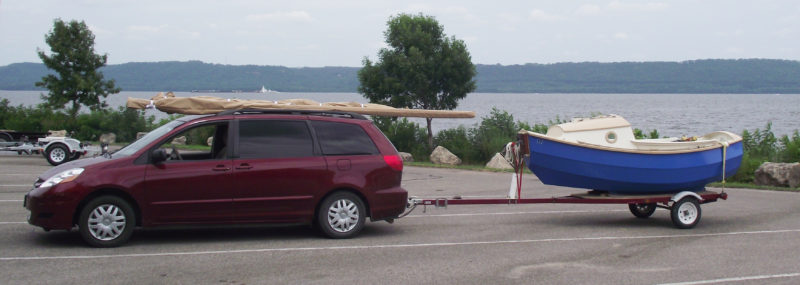
The diminutive SCAMP is easily trailered, rigged, and launched.
With its quick launching capabilities, SCAMP would work well as a family-friendly daysailer. There is space enough for four adults in relative comfort (three is better; two is luxurious), and the boat’s stability makes it a comfortable ride even for the elderly and infirm, young children, or passengers who might simply be a bit nervous around boats. The boom is high overhead, minimizing the risk of hitting an inexperienced passenger, and the seats are wide and comfortable.
Cruising solo or two-up is where SCAMP really shines. The 8′3″ x 29″ cockpit sole provides ample space for one person to sleep aboard very comfortably (the offset centerboard is hidden in the starboard seat face), and filler planks between seats can be used to create a double bunk. The benches themselves (6′8″ by 17.5″) offer a place to stretch out but aren’t quite wide enough for sleeping. There is plenty of stowage space under the seats and cockpit. The “veranda” (a small cuddy/locker at the forward end of the cockpit) provides additional stowage, sitting headroom, and shelter from the wind, as well as a convenient place to anchor the forward edge of a cockpit tent. Forward of the veranda’s bulkhead there are 8.5 cubic feet of sealed stowage that provide extra buoyancy well above the waterline, just where it would be most useful in a knockdown. And of course, like all small boats, a SCAMP can easily travel to windward at 60 mph, pulled on a small lightweight trailer by a small four-cylinder car.
Tom Pamperin ( www.tompamperin.com ) is a frequent contributor to Small Boats Monthly and WoodenBoat.
SCAMP Particulars
LOA/11′11″ Beam/5′4″
Draft (board up)/7″ Weight (including rig)/420 lbs Water ballast/173 lbs
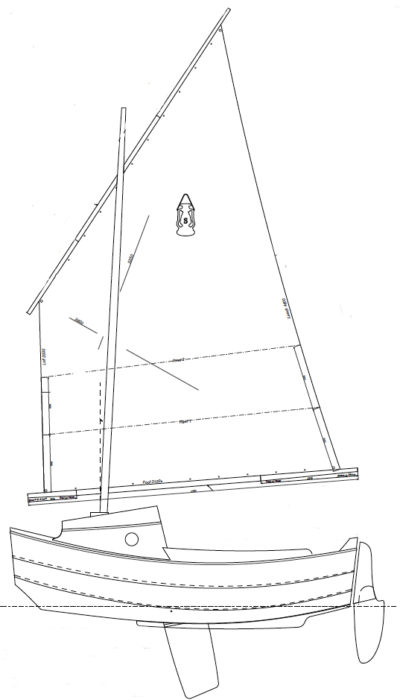
Plans and information are available from Small Craft Advisor . Their YouTube channel has several videos featuring the SCAMP, including a capsize trial with Howard Rice, below.
Is there a boat you’d like to know more about? Have you built one that you think other Small Boats Monthly readers would enjoy? Please email us!
Share this article
Join The Conversation
We welcome your comments about this article. If you’d like to include a photo or a video with your comment, please email the file or link.
Comments (4)
Great article! Thanks. I especially enjoyed the fact that during the capsize test, Howard did not lose his hat! Now that’s a sailor. I’ve always been off put by the punt bow, but seeing the boat in action, I can now appreciate it.
That boat did not want to capsize…
Thanks for the kind words about the article; I enjoyed yet another excuse to go sailing aboard a Scamp. It’s a fun and very very capable little boat, that’s for sure.
These are great wee boats, totally sold on the concept especially the seaworthiness. The only thing I would do differently is wear a safety harness in winds like that in the video! I could quite easily see the boat sailing off while you flounder around in the briny!
Comments are closed.
Stay On Course
More From This Issue
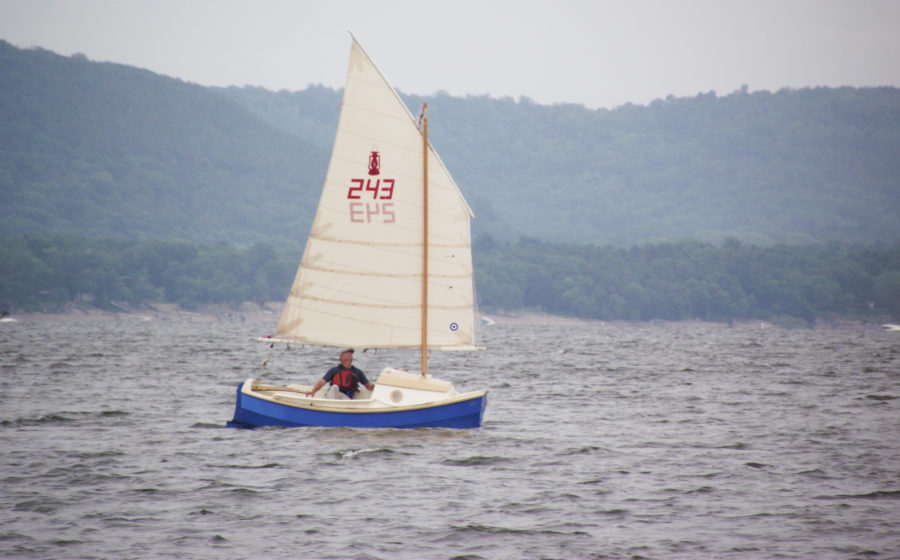
Never mind that until grounding on a mudflat less than 30 miles from the finish line, SCAMP #4 breezed through a difficult year in the 300-mile Everglades Challenge adventure race…
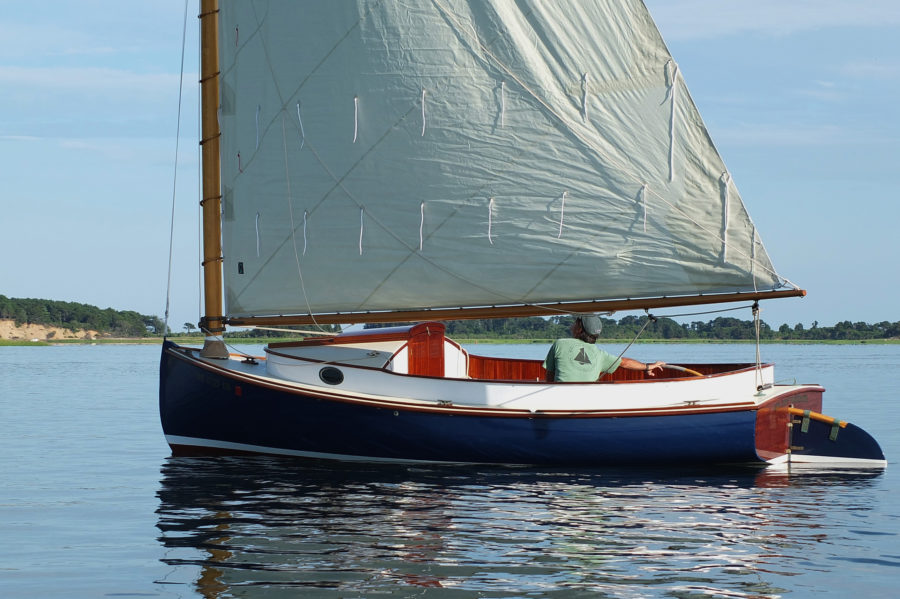
The Caracal
Arey’s Pond is a green, bowl-shaped jewel, one of several ponds in Orleans, Massachusetts, that give access, through narrow, winding waterways, to Little Pleasant Bay and, just to the south,…
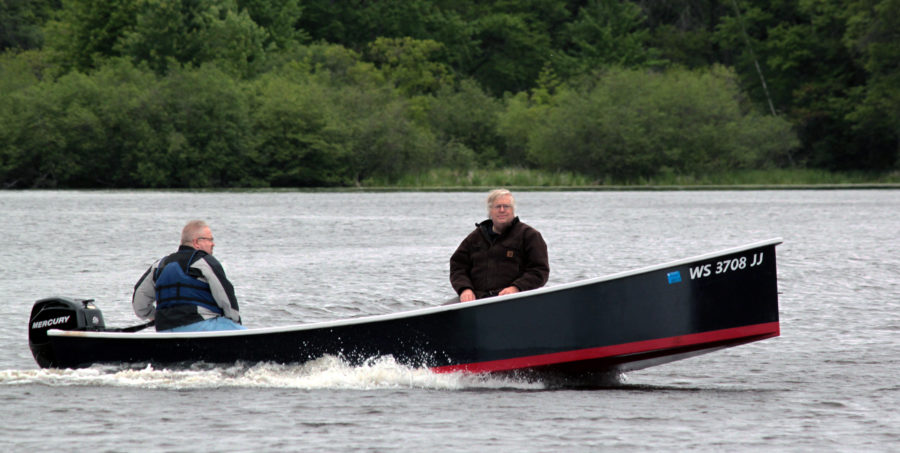
I’ve had a copy of Phil Bolger’s book Boats With An Open Mind for a long time, and I’ve always liked the looks of the Clam Skiff he designed for…
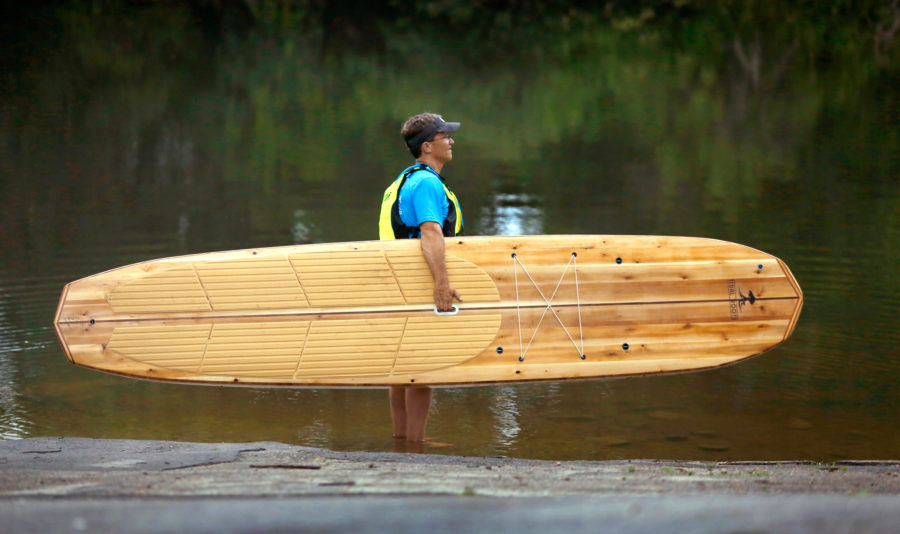
The Sand Bar by Tidal Roots
I was paddling on a placid Royal River with my four-year-old son Noah kneeling in front of me on a wooden Tidal Roots stand-up-paddle (SUP) board. The water hissed quietly…
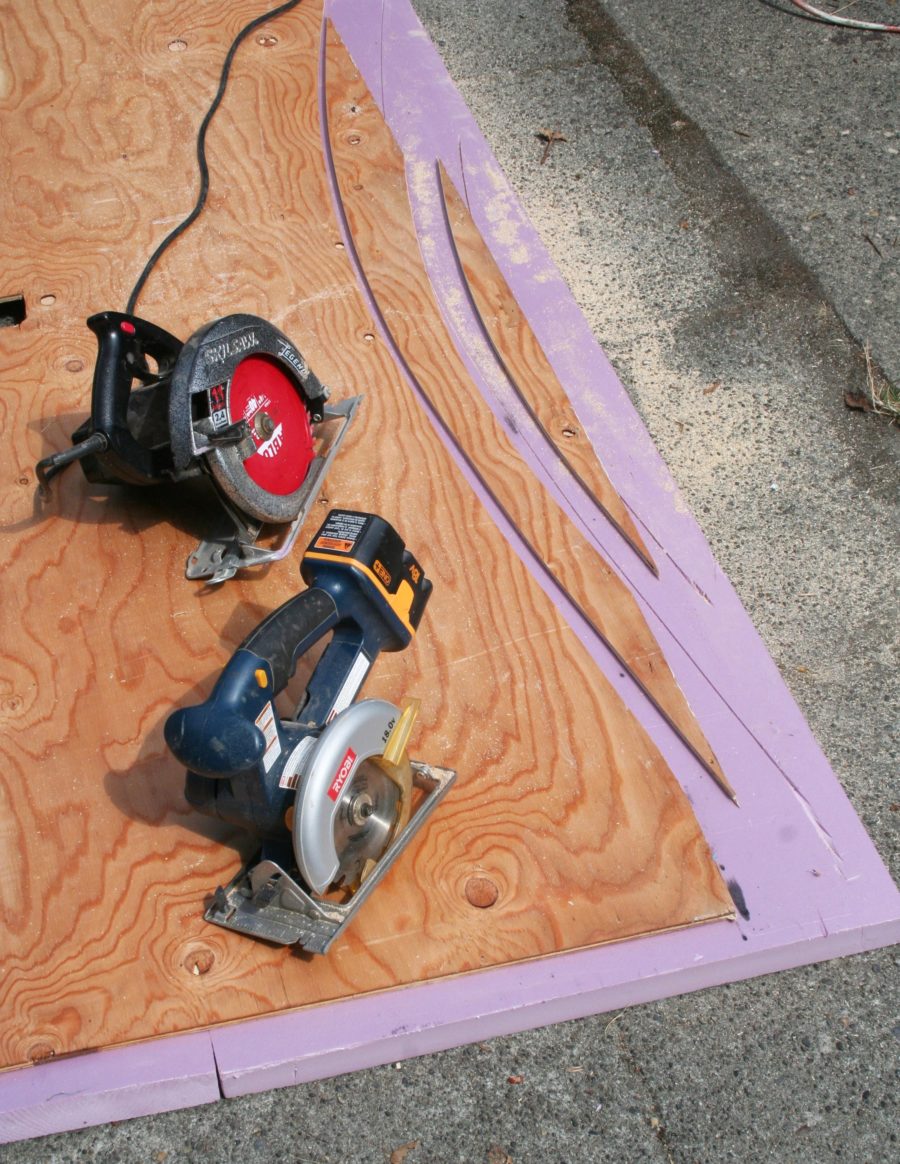
The Taming of the Sheet
Most of us who build boats at home do not have the facilities needed to handle 4′ x 8′ sheets of marine plywood with ease. I’ve always found it challenging…
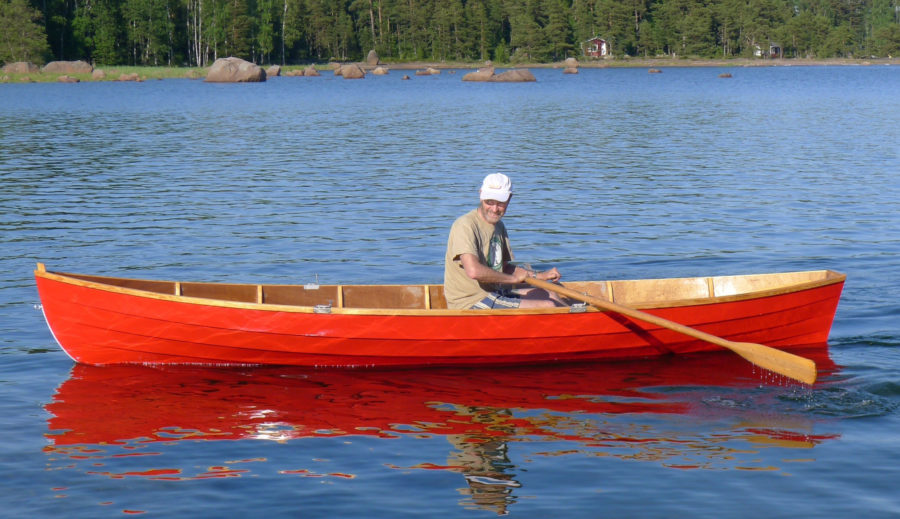
In Finland and much of the eastern Baltic region, networks of interlocking lakes were once the only links between settlements and farms; boats were the only form of transportation. The…
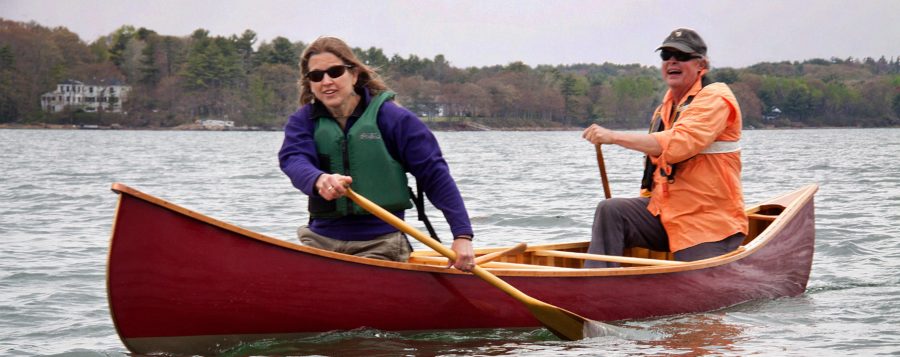
The E.M. White Guide Canoe
Not long after our first wedding anniversary—celebrated with an overnight canoe trip on the Narraguagus River in Maine—Sharon and I acquired our first boat, an 18′ Grumman aluminum canoe, complete…

Made in Vermont
I have always loved wooden boats of all kinds, but especially dories, for their elegant simplicity of design, the way they look upon the water, the way they handle in…
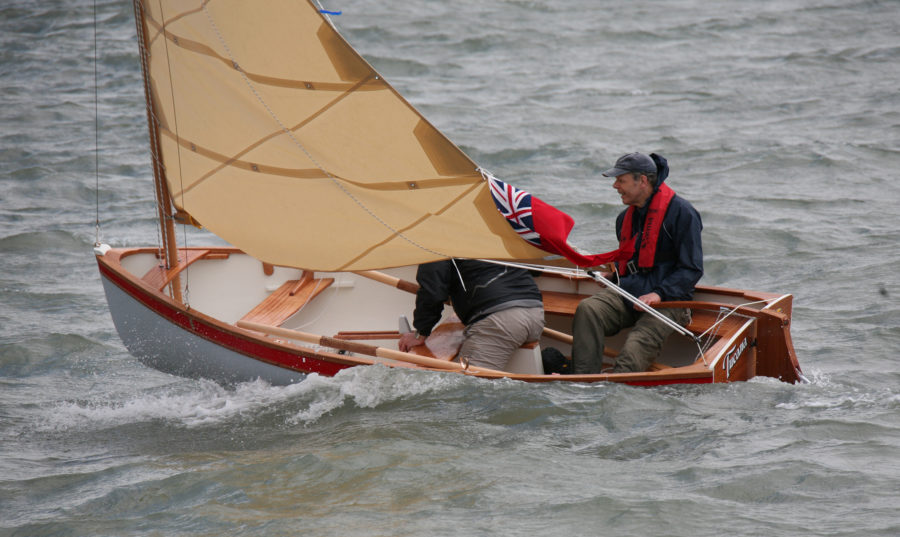
The Mallard
When the now-defunct magazine The Boatman was launched in the early 1990s, one of its objectives was to provide boat plans suitable for amateur construction. One such boat was the…
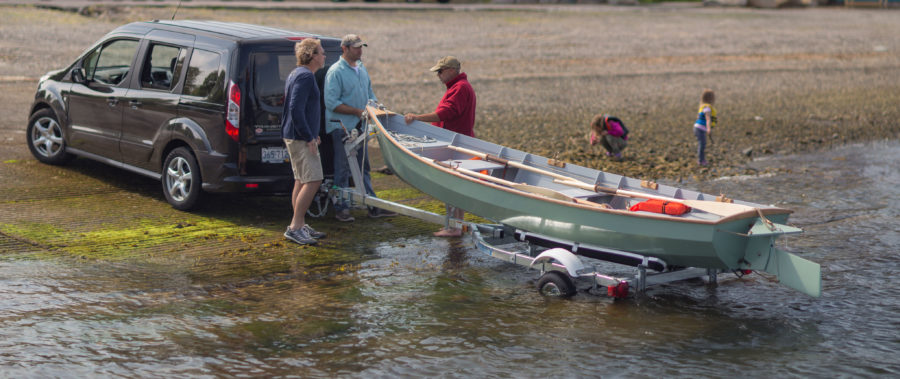
ZO Boats is a new company started by Bill Koffler and Scott O’Connell, partners in Aquidneck Custom Boatbuilding, a company specializing in high-tech composite construction. Involved in modern yacht construction…
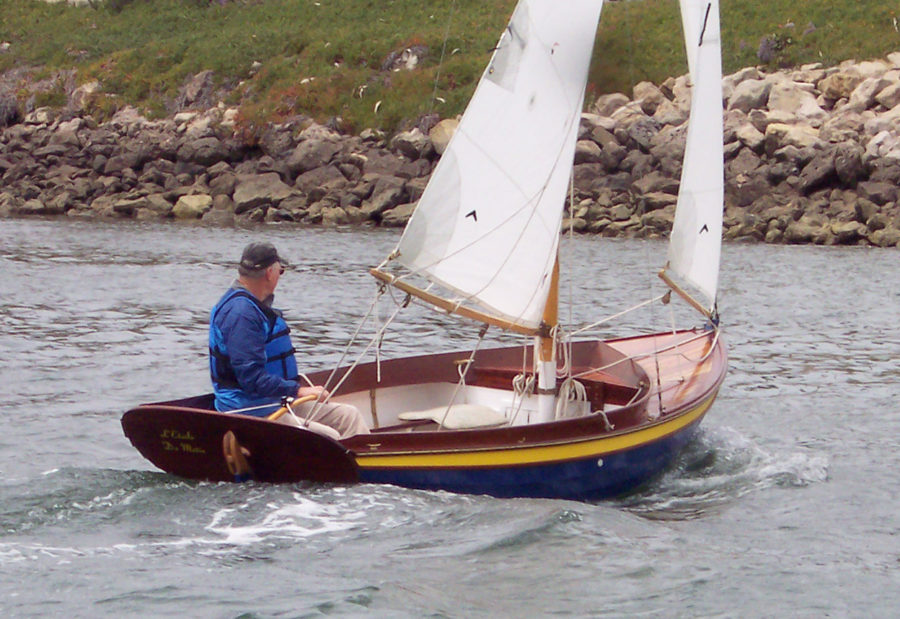
The Somes Sound 12½
A century ago Nathanael Herreshoff designed a 16′ keelboat known widely as the H 12½ after its 12′6″ waterline length. She was intended to handle the steep chop and strong…
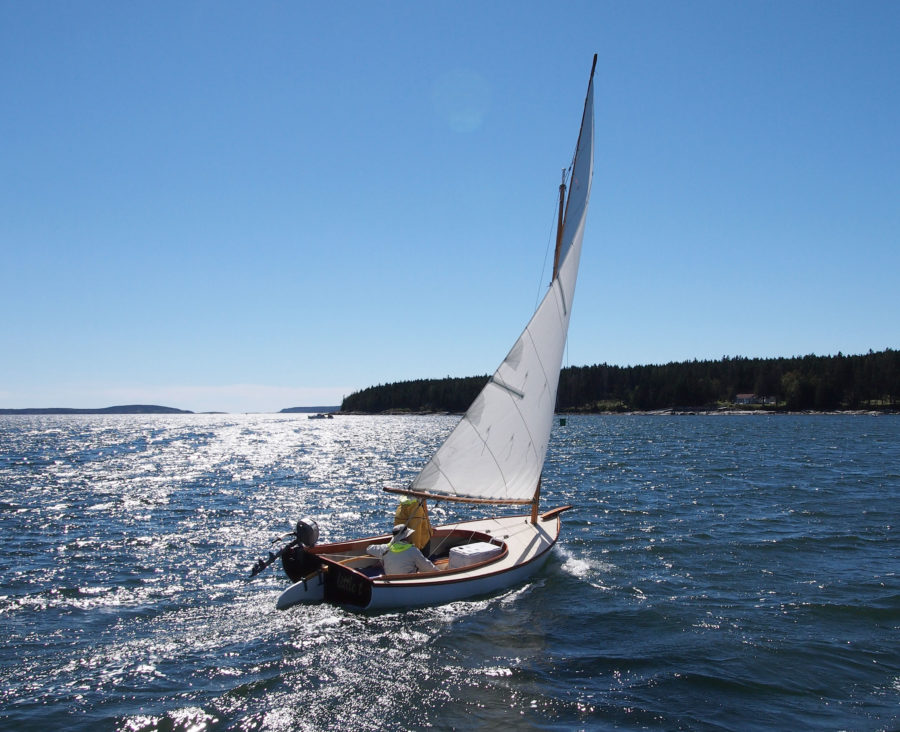

The Marsh Cat
I had spent a long time looking for a boat that I could build to sail the waters of Chesapeake Bay and beyond. The boat would need to be able…
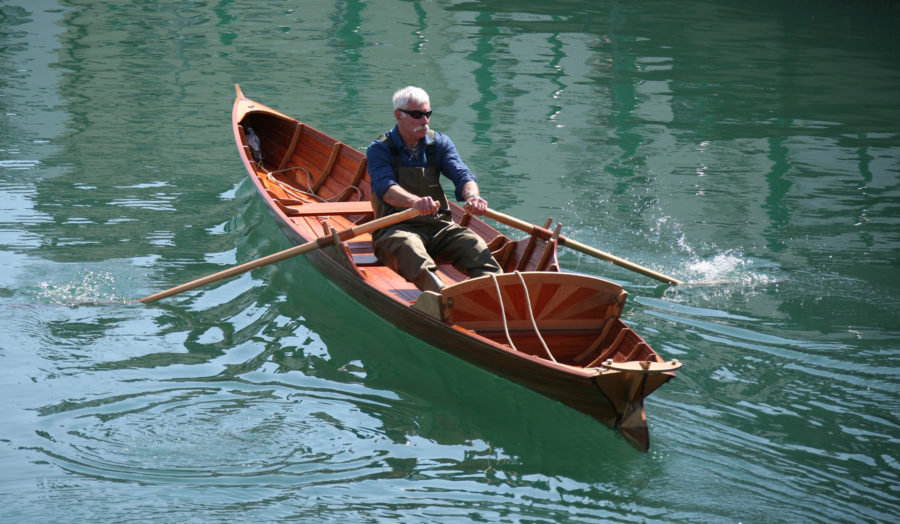
Within the pages of Eric McKee’s Working Boats of Great Britain there are drawings of a 24′ Thames skiff attributed to W.A.B. Hobbs* at Henley-on-Thames in the very early part…
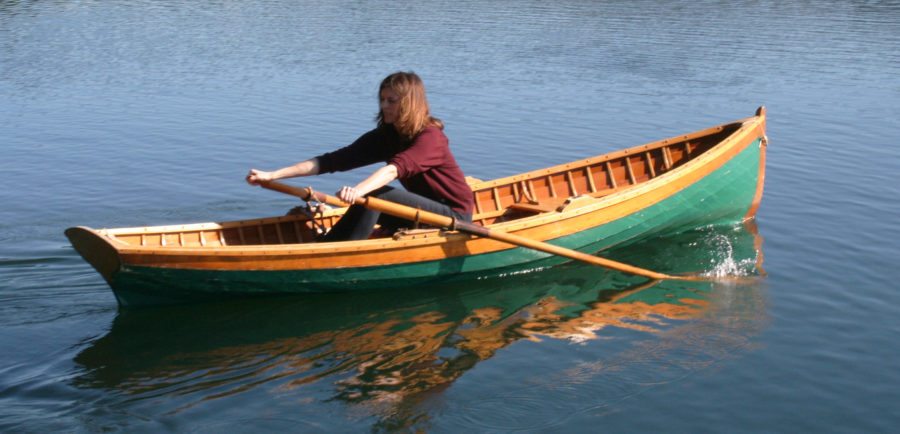
A Lapstrake Livery Boat
What was left of the boat rotting in the brambles on the north shore of Clear Lake in Western Washington was once a very fast boat under oars. Back in…
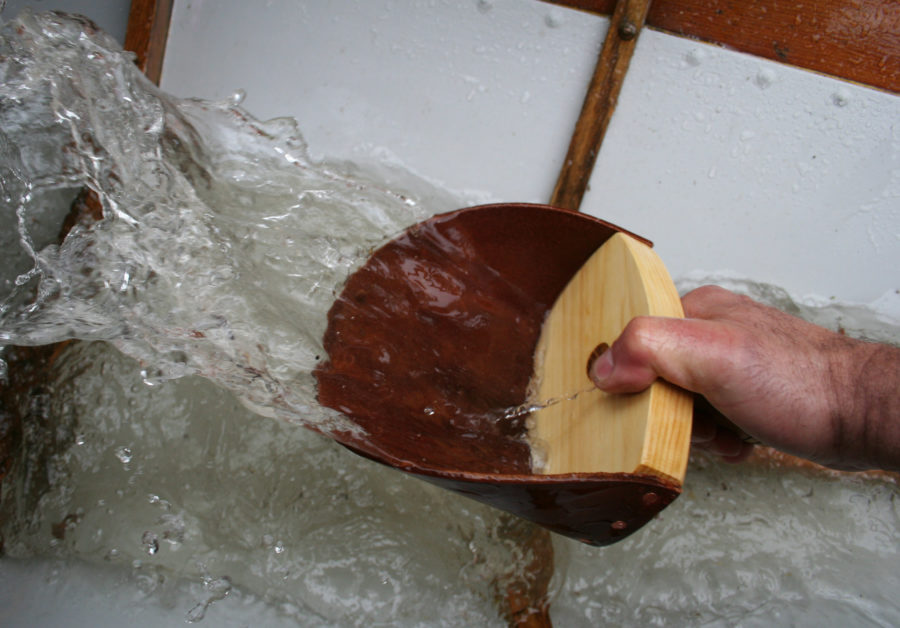
Making a Wood and Leather Scoop Bailer
Once upon a time the boat sharps on the Delaware River were sailing 15 footers with sail areas running to 400 sq ft. No self-bailers, no buoyancy tanks, no crash…
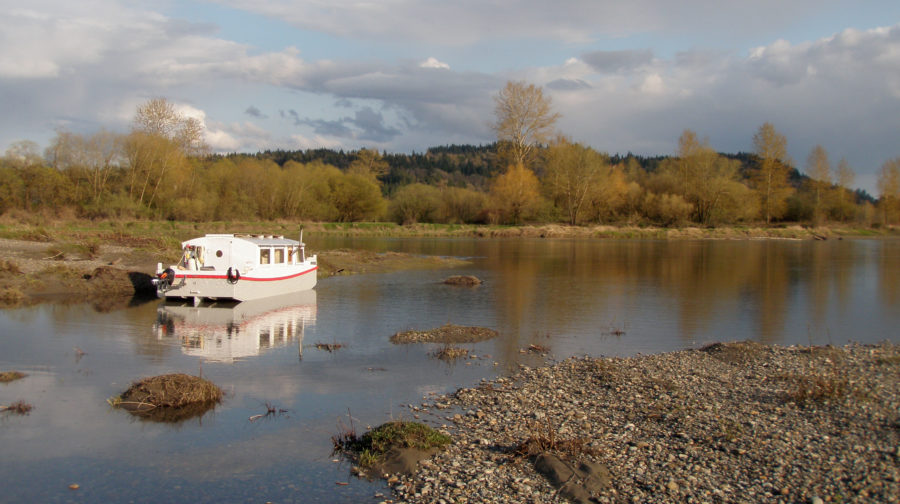
The Escargot Canal Cruiser
I was sitting in the cabin of the Escargot canal cruiser BONZO, a boat my son, Nate, and his friend Bobby Calnan built the summer after they’d graduated from high…
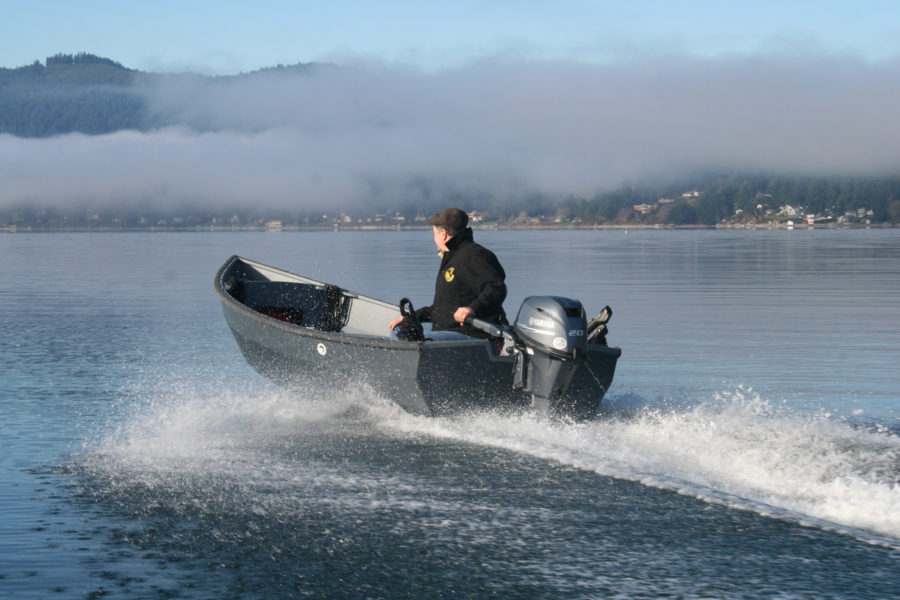
The Candlefish 13
Sam Devlin’s Candlefish 13 began with a client’s detailed request for the design of an outboard skiff suitable for the lakes of Alaska’s Far North. It had to be light…
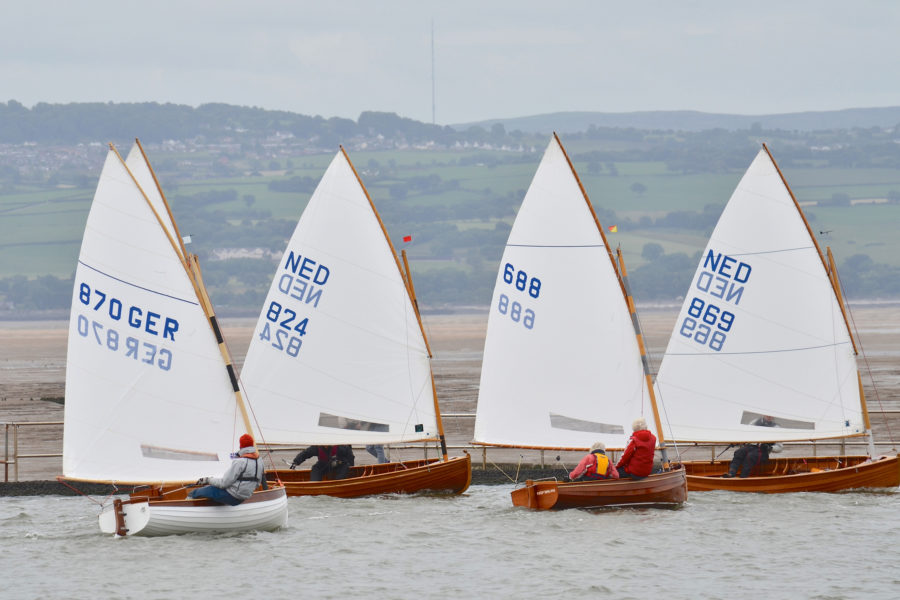
The International 12-Foot Dinghy
In 1913, shortly before the start of WWI, England’s Boat Racing Association (BRA), a small club of sailing enthusiasts, called for a design to comply with the following requirements: length…
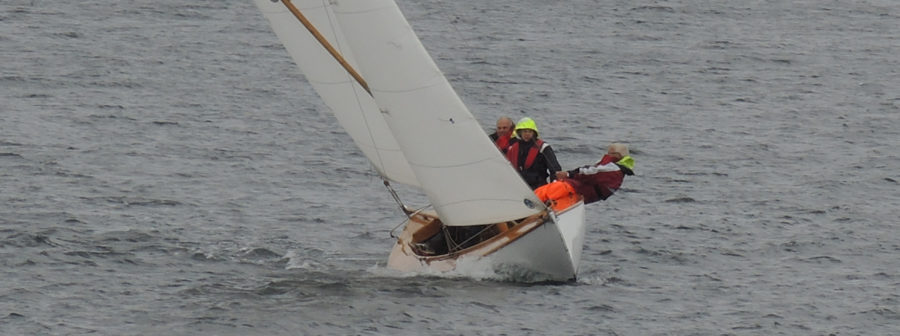
The Færder Snekke
Norway’s Færder snekker constitute a small racing class that hails from outside of Tjøme in the country’s Vestfold region, 55 nautical miles south of Oslo. The two-part name reflects the…
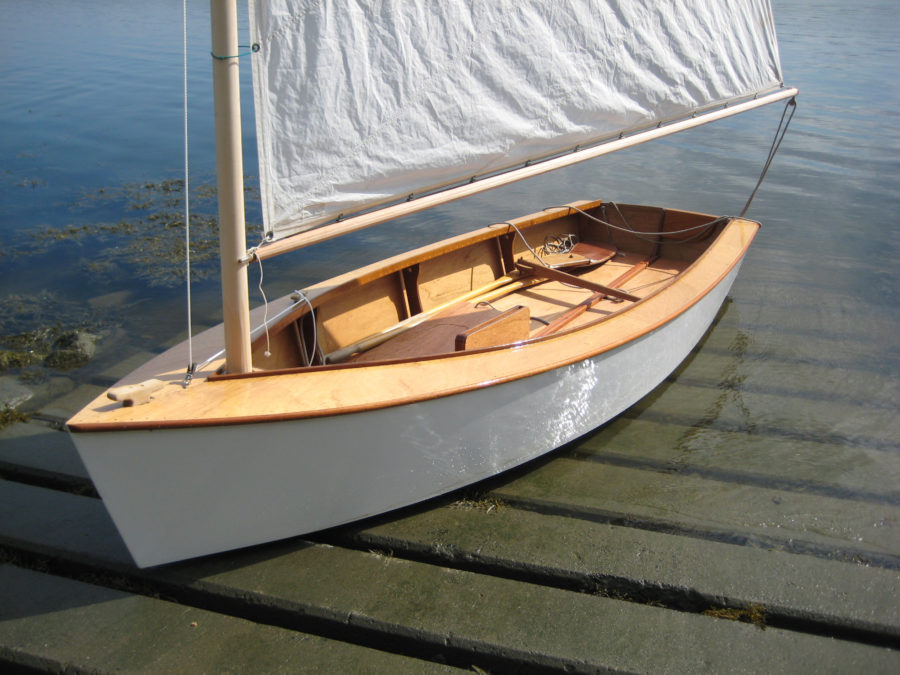
The MerryMac
The MerryMac catboat tends to make the blood hum with a sense of adventure and challenge. Its owners claim that it has always been so since the first of about…
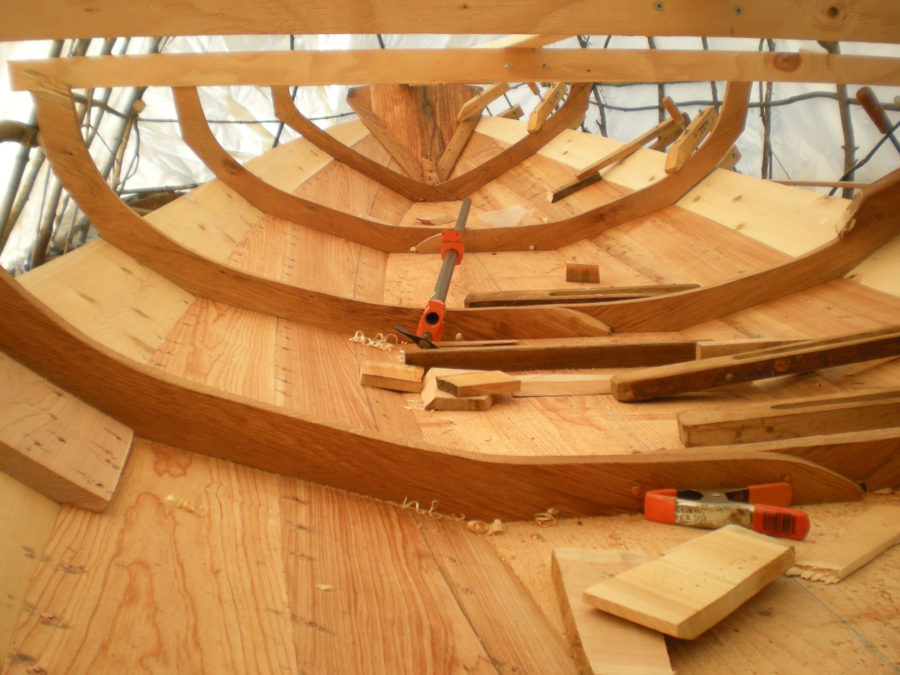
The Mower Dory
One day in the early 1990s, a local contractor visited my boatbuilding shop in Marblehead, Massachusetts, telling me he’d been hired to convert an old boatshop into a playhouse. “The…
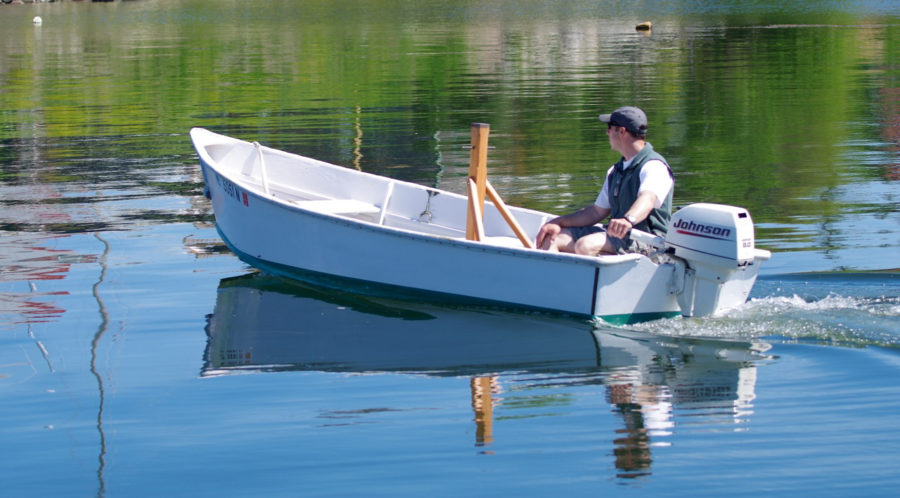
The Willis Boats of Maine’s Dark Harbor
At Dark Harbor, Maine, the legacy of the Rossiter Skiff outshines that of even its most popular fiberglass counterparts. Dark Harbor, located on the mid-coast island of Islesboro, is home…
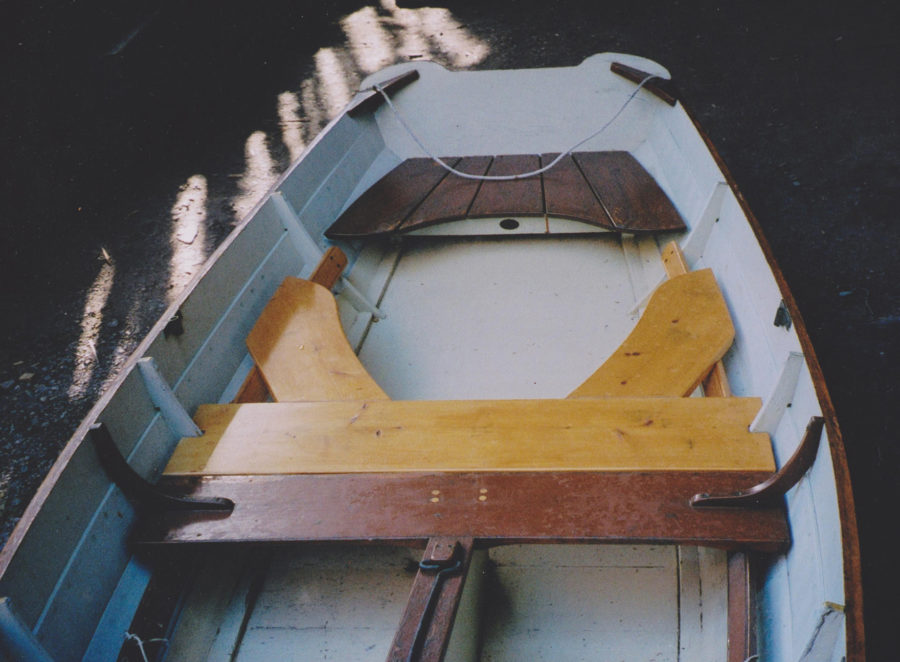
Comfortable Seating for Sailing a Small Rowing-and-Sailing Skiff
As age makes its inevitable changes to the sailor’s once supple joints, certain positions that were once assumed without thought become uncomfortable, if not actually painful. When I was younger…
More Boat Profile

Salish Voyager
We needed a boat we could row, sail, and beach. We began our search by visiting Gig Harbor Boat Works, where the Salish Voyager was still in the design stage.…
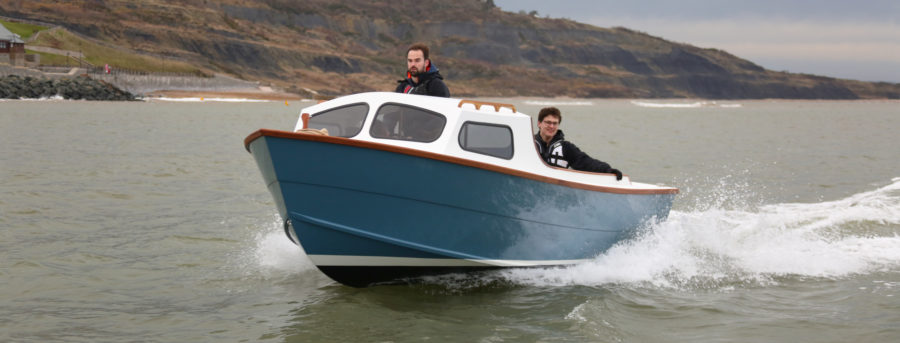
On the day SADIE was launched, the wind was light and there was a slight chop off Lyme Regis. With five of us on board and the engine at 5,000…
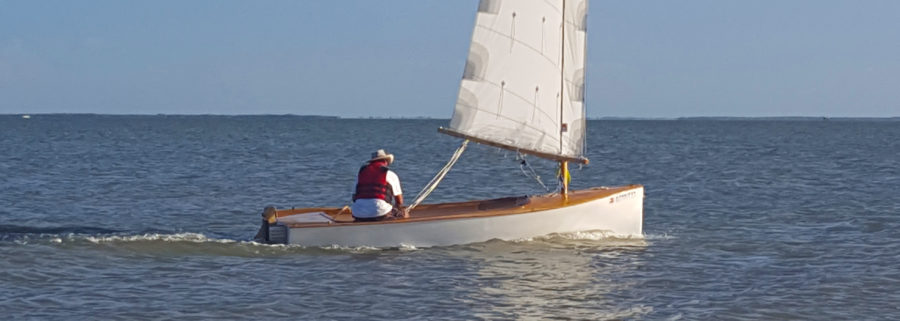
Saturday Night Special
I had been hearing about New Zealand boat designer John Welford’s idea for the Saturday Night Special for a few years: a fast beach cruiser so simple to build that…
Subscribe Today!
Become a subscriber today and you’ll recieve a new issue every month plus unlimited access to our full archive of backlogged issues.
Already a subscriber? Sign In
Subscribe For Full Access
Flipbooks are available to paid subscribers only. Subscribe now or log in for access.

- Boats & Gear
- Instructional
- Cruising Stories
- Cruising Destinations
- Race Results
- Race Reports
- Racing Technique
- Submit a Classified Ad
- Boats for Sale
- All Classifieds
- Terms & Conditions
- Your Dashboard
- Seattle Area Racing Calendar (SARC)
- 48° North Cruising Rally
- Croatia Flotilla
- Close to the Water: My Boat Crush

When I first saw a Scamp sailboat, I thought it looked like an oversized children’s bath toy. It seemed to bob around sitting too high in the water, and that snub nose made me feel that part of the boat was missing. But once aboard, the high sides created a dry ride and an atmosphere of safety. With a small cuddy forward, and lots of hatches for neatly stowing gear, it felt serene compared to some of the open boats I normally admire, where gear and stray equipment clutter their cockpits.
The Small Craft Advisor Magazine Project (better known as SCAMP) is an increasingly popular small sailboat that can be built from plans or a kit, as well as ordered as a ready to sail fiberglass model constructed locally by Gig Harbor Boat Works. With a 100-square-foot sail, and measuring just shy of 12 feet with a beam of about five feet, the boat seems like it shouldn’t sail well at all, but somehow it does.
I’ve been out on Scamps enough times to not be surprised by their abilities. For such a small boat, I’m continually impressed by how comfortable and spacious the seven-foot long cockpit, with benches lining each side, and the five-foot cuddy make the boat feel. If I was blindfolded at the helm of a Scamp and you asked me how big a boat I was steering, I’d say something long and steady — maybe 20 feet. After all, I’d be sitting straight up, with my legs down in a well, not scrunched up like most dinghies. The tiller in hand would feel steady, with no signs of the boat wiggling due to any slight inattention.
I wasn’t alone in finding the aesthetics of the hull curious. “I became interested in Scamps very slowly. At first I did not really care for them,” my pal Randy Wheating wrote by email. “However, my big Chebacco was being used less and less.”
Many people construct their own Scamps as part of a class. Friend and lifelong sailor, Dale Simonson, told me, “I sort of ended up with a Scamp by mistake. Or, more like by happenstance. I was planning (or dreaming about planning) to build a boat in a few years… when I stumbled onto an upcoming ‘Scamp Camp,’ a group build of ten boats. Ten students, four instructors, two weeks, and come home with your own boat!”
Dale noted, “I wasn’t totally enamored with the design until I started to really consider the value of the workshop, and getting such a good jumpstart on a build. It wasn’t until we got into the build, and all the ensuing discussions with the instructors (in particular, John Welsford the designer, and Howard Rice the adventure sailor), that I fell in love with the concept and the approach of the design as a very small vessel that is capable of cruising my local near-shore waters of the Salish Sea.”
For some Scamp sailors, the camaraderie is a big part of the appeal of the boat. There’s an active online community as well as Red Lantern rallies where scads of Scamps congregate. But that’s not true for everyone. Samantha Ritchie, the captain of a fiberglass Scamp named Kerfuffle observed, “the Scamp community is mostly older white men. I like older white men, but that’s not really my group, so I am not into the ‘community’ thing very much. That being said, I love seeing other Scamps and always go chat with the owners.”
But like other people, Samantha appreciates the balance of simplicity and function. “I am very comfortable in the Scamp, and it’s a low fuss kind of boat. I am strong for a 65-year-old woman, but not as strong as I was 10 years ago. Despite that, I can easily put up the mast, pull the boat up on a beach, etc. No need for winches for any big jib — no jib!”
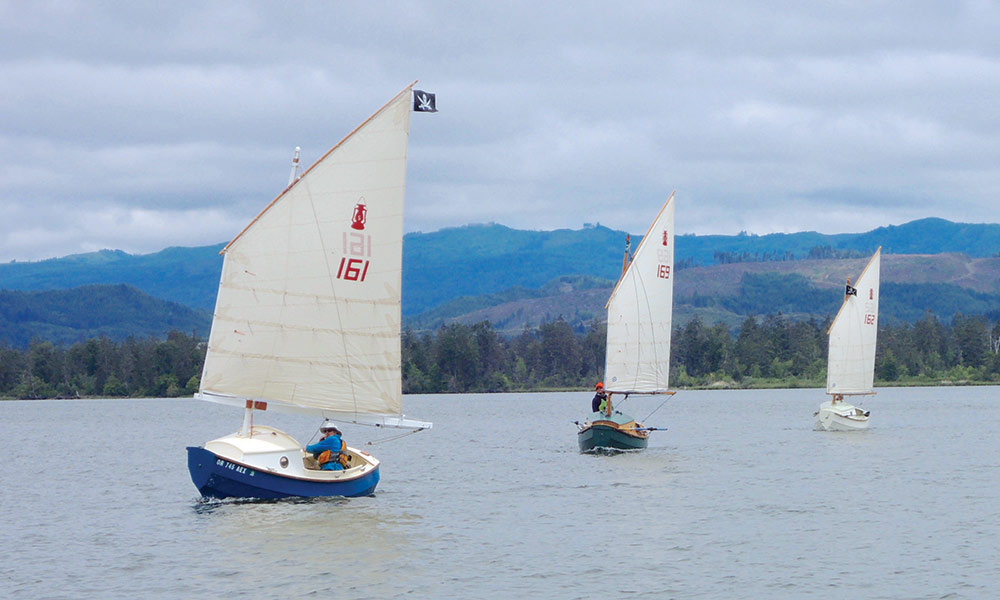
I initially expected the Scamp to sail like a bulldozer, slogging along pushing water. In reality, it moves smoothly under sail and turns on a dime, making sailing out of a marina or around other tight places deceptively easy. With only one sail and a short waterline, making 360 degree penalty turns actually feels like fun. I will admit one fault about my crush — as I’ve sailed alongside my friends in their Scamps, they are gradually outpaced by all but the shortest hulls.
I’ve been out in Scamps in a big blow, but when filled with 175 pounds of water ballast (integrated into cavities in the hull), I’ve been impressed with how stable they were. But, it wouldn’t be a sailboat if you didn’t get scared from time to time and yes, despite the broad beam and reefable sail, I’ve seen them capsize. Still, the boat is self rightable and floats high enough to bail with a little effort.

Besides being fun to sail, the Scamp is an able camp cruiser and despite its size, both Dale and Samantha have done overnight stints at anchor with their partners. Dale notes, “I think I’m a minimalist at heart, my wife and I lived in Volkswagen vans for two years, touring Europe and Australia. I love to row (and sail, even more) and don’t care much for motor boating. I have found backpacking, kayaking, camping, and living a bit ‘rough’ to be enjoyable… Big poofy pillows are allowed. Dutch ovens, too. It’s a very comfortable floating tent that turns into a kitchen, a lounge, and then a fun sailing machine… and fits in a single car garage.”
As I’ve started to play with the many strings and sticks attached to slightly larger boats, the simplicity of the Scamp keeps calling me. Sure I’d be slower and maybe not as sleek, but the comfort and adaptability of the Scamp in such a small package just keeps me smiling.
Bruce Bateau sails and rows traditional boats with a modern twist in Portland, Oregon. His stories and adventures can be found at www.terrapintales.wordpress.com.
Bruce Bateau
Bruce Bateau sails and rows traditional boats with a modern twist in Portland, Ore. His stories and adventures can be found at www.terrapintales.wordpress.com
Cruising Destinations , Featured
Destinations: Stuff Happens in Foggy Bay, Alaska
August 27, 2024

Race Reports , Featured
Northern Century 2024
August 23, 2024

Boating Lifestyle , Featured
Rum Running in the San Juan Islands
August 22, 2024

Tribal Canoe Journey: A Way of Life
August 21, 2024

Boats & Gear , Featured
August Products News
August 20, 2024

Boating News , Featured
Fall Boats Afloat Show Coming to South Lake Union
August 19, 2024

- News & Trends
- Dinghy sailing
- Multiple sailing dinghy
- Exhibitions
Multiple sailing dinghy 12′ Scamp traditional recreational catboat

Characteristics
12'00" (3.66 m)
Description
Other gig harbor products, boat 12 to 8 feet.

- Sailing dinghy
- Recreational sailing dinghy
- Catboat sailing dinghy
- Sailing skiff
- Children's sailing dinghy
- Traditional sailing dinghy

- My Boats & Boat Articles
- Many types of Boatbuilding Plans
- Free Stitch and Glue Boat Plans
- Characteristics of Carbon Fiber
Steps in Building SCAMP
Here are the various steps I took to build my John Welsford SCAMP from Plans. The steps are not all in perfect chronological order because I would stop and work on a different part, then go back to what I was doing.
I build without assistance and some of my decisions and methods might not be the best or fastest. They work though. Because I work alone I have to find some ways of doing things that might take longer but can be safely accomplished by one person. I got help turning the boat though. The instruction manual is quite vague on many points and I hope future builders will find this boat building record useful.
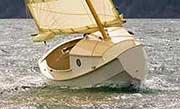
I try to be accurate and check my information, but mistakes happen.
- Skerry build
- Stitch & Glue Boatbuilding
- Free Boat Plans

Small Print
This information is for general knowledge and entertainment. It's not intended to replace plans or proper instructions. I'm not suggesting that was I did was the best way.




IMAGES
COMMENTS
The total combined area of the sails when sailing upwind. S.A. (reported) is the area reported by the builder. (Verses ** S.A. (100% Fore + Main Triangles) which is the area as defined by the rig measurements.) S.A. (reported) can differ depending on the size of the head sail used to calculate the S.A.
The Scamp is a seaworthy 12′ sailboat that can handle a good dose of adventure. Just under 12 feet in length, Scamp boasts an unusual combination of features that give her the unique ability to explore waters too shallow for a larger boat, while retaining most of the bigger boat's comforts and capabilities. An offset centerboard opens up ...
The SCAMP (acronym of Small Craft Advisor Magazine Project) is a wooden or fiberglass hulled Balanced Lug rigged sailing dinghy. The boat is 11 ft 11 in (3.63 m) long, and capable of accommodating four persons on a daysail or one to two for overnighting or extended cruising. Craig Wagner and Josh Colvin, editors of Small Craft Advisor Magazine ...
The rest is history: More building plans and kits for SCAMP have been sold over the years than any other small cruising boat we can think of. Besides the original wooden version, Gig Harbor Boat Works was licensed in 2013 to produce a fiberglass SCAMP, and the little giant killer—in wood and fiberglass—has since its debut been at the center of various small-boat rallies, workshops and ...
Exciting news that's been a long time coming . . . the Small Craft Advisor magazine released their first formal review of the SCAMP! For a bit of backstory, the SCAMP, which stands for Small Craft Advisor Magazine Project, was originally conceived by the magazine as a kit boat that would meet the needs of adventurous small craft sailors.It was designed by a team of passionate and ...
Official SCAMP Design Logo Burgee. $34.95. Sort by: Product: A-Z Product: Z-A Price: Low-High Price: High-Low Default: Ascending Default: Descending Sales: Ascending Sales: Descending. Show: 5 10 15 20 25 30 35 40 45 50. Our own youthful dreams often featured small boats in starring roles. Aboard these simple, stalwart little vessels we'd ...
The Scamp is a seaworthy 12' sailboat that can handle a good dose of adventure. Just under 12 feet in length, Scamp boasts an unusual combination of features...
SCAMP Building Plans. Price$149.00. Add to Cart. SCAMP Articles Package. Price$9.95. Add to Cart. SCAMP Brass Name Plate. Price$29.00. Add to Cart.
Our fiberglass SCAMP got a fantastic write-up in the April 2014 issue of 48 North! ... Sailing the SCAMP made me a believer that it actually would be a safe and enjoyable way to explore the San Juans, as well as just knocking around the bay for a fun day of sailing. The SCAMP had lots of surprises, all good.
Josh Colvin, who commissioned SCAMP—an acronym for Small Craft Advisor Magazine Project—wasn't looking for an ultimate adventure boat when he approached New Zealand designer John Welsford (see WB No. 225 for a profile on Welsford and his design work). "My initial goals for the boat were based largely on a 150-mile sail down the Columbia ...
The Small Craft Advisor Magazine Project (better known as SCAMP) is an increasingly popular small sailboat that can be built from plans or a kit, as well as ordered as a ready to sail fiberglass model constructed locally by Gig Harbor Boat Works. With a 100-square-foot sail, and measuring just shy of 12 feet with a beam of about five feet, the ...
The Scamp is a seaworthy 12′ sailboat that can handle a good dose of adventure. Just under 12 feet in length, Scamp boasts an unusual combination of features that give her the unique ability to explore waters too shallow for a larger boat, while retaining most of the bigger boat's comforts and capabilities. An offset centerboard opens up ...
SCAMP features an offset centerboard, massive flotation from sealed seats and stowage cabin, a water ballast tank holding 173 pounds of water, an after cabin "veranda" that functions like a hard dodger, and a flat bottom and skegs for beaching. PLANS: Complete plans now available on 7 24 x 36" sheets. A complete "Building guide" with suggested ...
To provide the best experiences, we use technologies like cookies to store and/or access device information. Consenting to these technologies will allow us to process data such as browsing behavior or unique IDs on this site. Not consenting or withdrawing consent, may adversely affect certain features and functions.
Scamp Kit Purchasing Information « by Editors » Wed Nov 21, 2012 9:46 am. 5 Replies 65532 Views Last post by Editors Wed Apr 19, 2017 7:59 am; SCAMP Plans ... Precision Sailboats; RowCruiser; General; ↳ News and Annoucements; ↳ General Discussion; Forum permissions.
Installing the bow eye. Making the portholes/deadlights. Oar Socket Placement. Making the SCAMP mast. Turning SCAMP over. Sanding, marking waterline and Painting outside of hull. Finishing shaping the Bottom. Making the centreboard. Centreboard pivot and details.
Thanks to an offset centerboard the cockpit sole/ single berth measures 25 x 77 inches, making accommodations almost luxurious for the solo sailor. Designed to be sailed, rowed and perhaps sculled, SCAMP can also be fitted with an outboard in place of her rudder-or with an optional mount for a trolling motor.
My sailing background is primarily crewing on larger racing boats, plus some cruising with other people running the show. On those boats auxiliary power is nearly a necessity, and a lot of them would probably get banged up pretty badly without it. I also had an opportunity to crew on a SCAMP the weekend before last.
A scamp is not a ferry... Sailing scamp is not a big deal, so any kid able to sail with a jolly-boat can do. The "cabin" is just a small open "roof"- sitting under an small table is a picture maybe. So if you don't want to sleep under the stars, you'll need to sew a tent. If there are 2 pepole to accommodate, you need fillers inbetween the seats.
Gig Harbor fiberglass Scamp sailboat in excellent condition. Covered and garaged storage by mature owner. This boat has many options including: floor hatch, bulkhead mounted compass, cockpit camping tent, 9' two piece oars, SS keel guard, tiller extension and tiller minder, two anchors, bilge hand pump, cockpit filler boards for sleeping two people, jiffy reefing, boom cover, boat cover and ...
SCAMP Rigging Kits. $69.99 - $329.99. Boom and RUNNING RIGGING plus Hardware 2 10-foot lengths of 3/16" Raid Braid for 1st Reef2 20-foot lengths of 3/16" Raid Braidfor 3rd Reef4 SD-043030 3" cleats for reefing lines1 60-foot length of 3/16" Raid Braid for Topping / Lazy jack system (cut to...
SailboatData.com …is a database that contains information on over 9000 production and semi-production sailboats dating back to the late 1800's. COMPARE BOATS To compare up to three boats at one time, click the (+) Remove a compared boat by clicking (-)
Kelsall Sailing Performance (KSP): Another measure of relative speed potential of a boat. It takes into consideration "reported" sail area, displacement and length at waterline. The higher the number the faster speed prediction for the boat. A cat with a number 0.6 is likely to sail 6kts in 10kts wind, a cat with a number of 0.7 is likely ...